T.J. Demos is an art historian and cultural critic who writes on contemporary art and visual culture, particularly in relation to globalization, politics, migration and ecology. Currently a Professor in the Department of History of Art and Visual Culture (HAVC) at UC Santa Cruz, and the founding director of the Center for Creative Ecologies, he is the author of several books, including Against the Anthropocene: Visual Culture and Environment Today (Sternberg Press, 2017), Decolonizing Nature: Contemporary Art and the Politics of Ecology (Sternberg Press, 2016), The Migrant Image: The Art and Politics of Documentary during Global Crisis (Duke University Press, 2013), and Return to the Postcolony: Spectres of Colonialism in Contemporary Art (Sternberg Press, 2013). Previous to his current appointment, Demos taught at University College London between 2005-2015.
Demos has also curated a number of art exhibitions, including Rights of Nature: Art and Ecology in the Americas [1] in 2010 and Uneven Geographies: Art and Globalisation [2] in 2015, both at Nottingham Contemporary (both co-curated with Alex Farqharson); Specters: A Cinema of Haunting [3] at the Reina Sofia Museum in Madrid in 2014; and Zones of Conflict, at Pratt Manhattan Gallery in New York in 2008.
Demos received his PhD in 2000 from Columbia University. His first book, which emerged from his doctoral thesis, was The Exiles of Marcel Duchamp (MIT Press, 2007). It situates Duchamp’s mixed-media projects, such as La Boîte-en-valise, and his installations, including the 1938 Surrealist exhibition in Paris, in the context of the early twentieth century’s world wars and nationalist formations. The text argues that Duchamp’s practice brought about an aesthetic negotiation of the experiences of geopolitical dislocation.
Demos’ work focuses on the intersection of contemporary art and politics (particularly in the areas of photography and moving-image art), and considers the ways that art is capable of inventing creative and critical approaches that analyze, defy, and provide alternatives to reigning political, social, and economic forms of neoliberal globalization. His recent writing investigates contemporary art’s relation to environmental crisis, and he recently guest-edited a special issue of the journal Third Text on "Contemporary Art and the Politics of Ecology" (no. 120, January 2013), and has written several essays on the subject, such as “The Post-Natural Condition” in Artforum [4]
This book looks at contemporary artists who have turned to documentary practice in order to investigate the mobile lives of migrants, refugees, stateless persons, and the politically dispossessed. His analysis considers the work of artists from Europe, the United States, the Middle East, and North Africa, which portrays the frequently negative conditions of neoliberal globalization, and which connects viewers to the lived experiences of economic and political crisis. The text includes close readings of works by Steve McQueen, The Otolith Group, Emily Jacir, Hito Steyerl Ahlam Shibli, Joana Hadjithomas and Khalil Joreige, Ursula Biemann, Lamia Joreige, Rabih Mroué, Walid Raad, Yto Barrada, Ayreen Anastas and Rene Gabri, Goldin+Senneby. It argues that these artists propose innovative ways to approach a politics of social justice and equality, and historical consciousness, even while operating in an aesthetic domain that is post-representational and deterritorialized.
This text examines the video and photographic projects by Sven Augustijnen, Vincent Meessen, Zarina Bhimji, Renzo Martens, and Pieter Hugo. The book traces the work of these artists who have each travelled to former European colonies in Sub-Saharan Africa in recent years in order to investigate past and present traumas and injustices, resulting in projects that were also made around the time of the 50th anniversary of the independence of numerous African countries. Addressing the larger context of failed states, increasing socio-political and economic inequality, and the continuing US-led military campaigns for security, resources, and economic supremacy worldwide, the book contends that artists today are critically investigating the aesthetics and image systems of neoliberalism and global crisis. Arguing that the past colonial experience continues to haunt those living in the present, but lies repressed, the book considers these artists’ voyages as constituting a “reverse migration,” a return to the African postcolony, “which drives an ethico-political as well as an aesthetic set of imperatives: to learn to live with ghosts, but to do so more justly.” (back cover).
Demos reads Birnbaum's video art in relation to media theory, postmodernist appropriation aesthetics, and the politics of feminism, and considers the pioneering attempts of the artist to develop the transformative capabilities of the medium of video.
Demos' text analyses the artist’s installations and conceptual mixed-media pieces – such as his La Boîte-en-valise, which Duchamp called his “portable museum.” The book places these project in relation to the aesthetic and geopolitical dislocations of early twentieth-century nationalisms and world war.
In 2014, Demos was awarded the prestigious Frank Jewett Mather Award for art criticism from the College Art Association. [5]
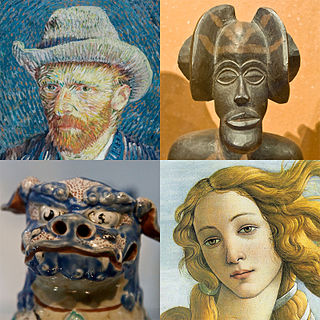
Art is a diverse range of human activity, and resulting product, that involves creative or imaginative talent expressive of technical proficiency, beauty, emotional power, or conceptual ideas.

Aesthetics, is a branch of philosophy that deals with the nature of beauty and taste, as well as the philosophy of art. It examines aesthetic values, often expressed through judgments of taste.
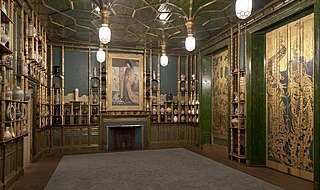
Aestheticism was an art movement in the late 19th century which privileged the aesthetic value of literature, music and the arts over their socio-political functions. According to Aestheticism, art should be produced to be beautiful, rather than to serve a moral, allegorical, or other didactic purpose, a sentiment exemplified by the slogan "art for art's sake." Aestheticism originated in 1860s England with a radical group of artists and designers, including William Morris and Dante Gabriel Rossetti. It flourished in the 1870s and 1880s, gaining prominence and the support of notable writers such as Walter Pater and Oscar Wilde.
Conceptual art, also referred to as conceptualism, is art in which the concept(s) or idea(s) involved in the work take precedence over traditional aesthetic, technical, and material concerns. Some works of conceptual art, sometimes called installations, may be constructed by anyone simply by following a set of written instructions. This method was fundamental to American artist Sol LeWitt's definition of conceptual art, one of the first to appear in print:
In conceptual art the idea or concept is the most important aspect of the work. When an artist uses a conceptual form of art, it means that all of the planning and decisions are made beforehand and the execution is a perfunctory affair. The idea becomes a machine that makes the art.
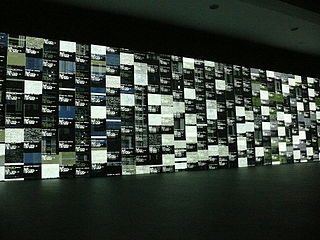
Postmodern art is a body of art movements that sought to contradict some aspects of modernism or some aspects that emerged or developed in its aftermath. In general, movements such as intermedia, installation art, conceptual art and multimedia, particularly involving video are described as postmodern.

Fountain is a readymade sculpture by Marcel Duchamp in 1917, consisting of a porcelain urinal signed "R. Mutt". In April 1917, an ordinary piece of plumbing chosen by Duchamp was submitted for an exhibition of the Society of Independent Artists, the inaugural exhibition by the Society to be staged at the Grand Central Palace in New York. When explaining the purpose of his readymade sculpture, Duchamp stated they are "everyday objects raised to the dignity of a work of art by the artist's act of choice." In Duchamp's presentation, the urinal's orientation was altered from its usual positioning. Fountain was not rejected by the committee, since Society rules stated that all works would be accepted from artists who paid the fee, but the work was never placed in the show area. Following that removal, Fountain was photographed at Alfred Stieglitz's studio, and the photo published in the Dada journal The Blind Man. The original has been lost.
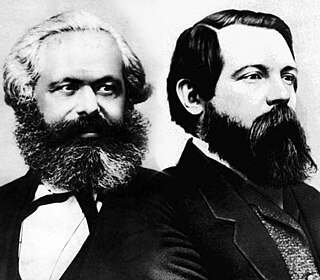
Marxist aesthetics is a theory of aesthetics based on, or derived from, the theories of Karl Marx. It involves a dialectical and materialist, or dialectical materialist, approach to the application of Marxism to the cultural sphere, specifically areas related to taste such as art, beauty, and so forth. Marxists believe that economic and social conditions, and especially the class relations that derive from them, affect every aspect of an individual's life, from religious beliefs to legal systems to cultural frameworks. From one classic Marxist point of view, the role of art is not only to represent such conditions truthfully, but also to seek to improve them ; however, this is a contentious interpretation of the limited but significant writing by Marx and Engels on art and especially on aesthetics. For instance, Nikolay Chernyshevsky, who greatly influenced the art of the early Soviet Union, followed the secular humanism of Ludwig Feuerbach more than he followed Marx.
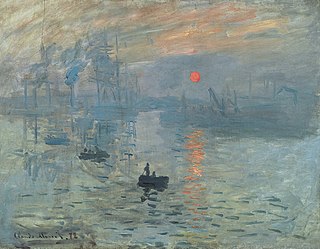
Art historians and philosophers of art have long had classificatory disputes about art regarding whether a particular cultural form or piece of work should be classified as art. Disputes about what does and does not count as art continue to occur today.

Johanna Drucker is an American author, book artist, visual theorist, and cultural critic. Her scholarly writing documents and critiques visual language: letterforms, typography, visual poetry, art, and lately, digital art aesthetics. She is currently the Martin and Bernard Breslauer Professor in the Department of Information Studies at the Graduate School of Education and Information Studies at UCLA.

Art history is the study of aesthetic objects and visual expression in historical and stylistic context. Traditionally, the discipline of art history emphasized painting, drawing, sculpture, architecture, ceramics and decorative arts; yet today, art history examines broader aspects of visual culture, including the various visual and conceptual outcomes related to an ever-evolving definition of art. Art history encompasses the study of objects created by different cultures around the world and throughout history that convey meaning, importance or serve usefulness primarily through visual representations.
Ecological art is an art genre and artistic practice that seeks to preserve, remediate and/or vitalize the life forms, resources and ecology of Earth. Ecological art practitioners do this by applying the principles of ecosystems to living species and their habitats throughout the lithosphere, atmosphere, biosphere, and hydrosphere, including wilderness, rural, suburban and urban locations. Ecological art is a distinct genre from Environmental art in that it involves functional ecological systems-restoration, as well as socially engaged, activist, community-based interventions. Ecological art also addresses politics, culture, economics, ethics and aesthetics as they impact the conditions of ecosystems. Ecological art practitioners include artists, scientists, philosophers and activists who often collaborate on restoration, remediation and public awareness projects.
A theory of art is intended to contrast with a definition of art. Traditionally, definitions are composed of necessary and sufficient conditions and a single counterexample overthrows such a definition. Theorizing about art, on the other hand, is analogous to a theory of a natural phenomenon like gravity. In fact, the intent behind a theory of art is to treat art as a natural phenomenon that should be investigated like any other. The question of whether one can speak of a theory of art without employing a concept of art is also discussed below.
Social practice or socially engaged practice is an art medium that focuses on engagement through human interaction and social discourse. Social practice goes by many names, including relational aesthetics, new genre public art, socially engaged art, dialogical art, and participatory art. Social practice work focuses on the interaction between the audience, social systems, and the artist or artwork through aesthetics, ethics, collaboration, methodology, antagonism, media strategies, and/or social activism.

Maurizio Lazzarato is an Italian sociologist and philosopher, residing in Paris, France. In the 1970s, he was an activist in the workers' movement in Italy. Lazzarato was a founding member of the editorial board of the journal Multitudes. He is a researcher at Matisse/CNRS, Pantheon-Sorbonne University, and a member of the International College of Philosophy in Paris.
e-flux publications includes both the e-flux journal and e-flux journal reader series. The monthly art publication e-flux journal features essays and contributions by contemporary artists and thinkers. The e-flux journal reader series was initiated in 2009 as a joint imprint with Sternberg Press.
Roee Rosen is an Israeli multidisciplinary artist, writer and filmmaker.

Joana Hadjithomas and Khalil Joreige are Lebanese filmmakers and artists. Their work includes feature and documentary films, video and photographic installations, sculpture, performance lectures and texts.

La Boîte-en-valise is a type of mixed media assemblage by Marcel Duchamp consisting of a group of reproductions of the artist's works inside a box that was, in some cases, accompanied by a leather valise or suitcase. Duchamp made multiple versions of this type between 1935 and 1966. Titled From or by Marcel Duchamp or Rrose Sélavy (de ou par Marcel Duchamp ou Rrose Sélavy [Boîte-en-valise], Duchamp conceived of the boxes as a portable museum:
Instead of painting something new, my aim was to reproduce the paintings and objects I liked and collect them in as small a space as possible. I did not know how to go about it. I first thought of a book, but I did not like the idea. Then it occurred to me that it could be a box in which all my works would be collected and mounted like in a small museum, a portable museum, so to speak. This is it, this valise.

Giovanni Aloi is an author and curator specializing in the representation of nature in modern and contemporary art. He teaches art history and visual culture at School of the Art Institute of Chicago. He is the Founder and Editor in Chief of Antennae: The Journal of Nature in Visual Culture and is the co-editor of the University of Minnesota Press book series Art after Nature. Aloi is also USA correspondent for Esse Magazine Art+Opinion.

Jaleh Mansoor is an Iranian-born Canadian art historian, critic, and theorist of modern and contemporary art. She is an associate professor in the faculty of Art History, Visual Art and Theory at the University of British Columbia.